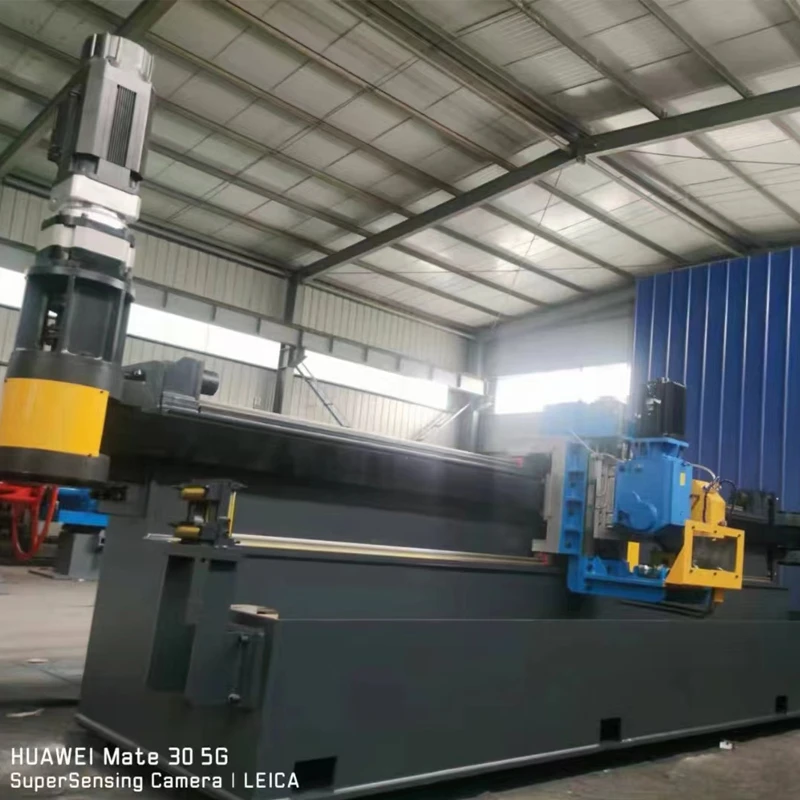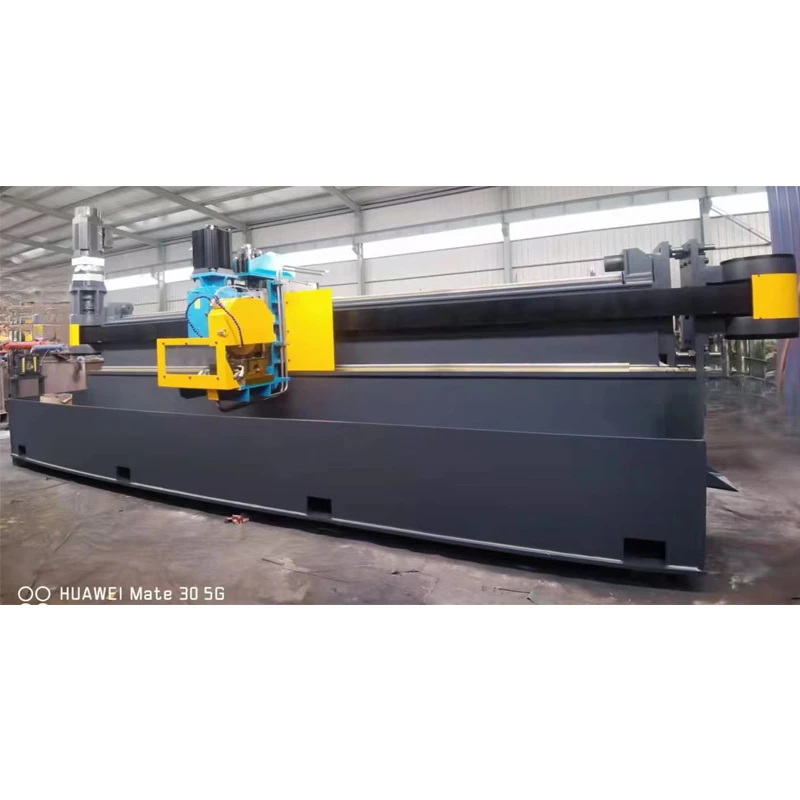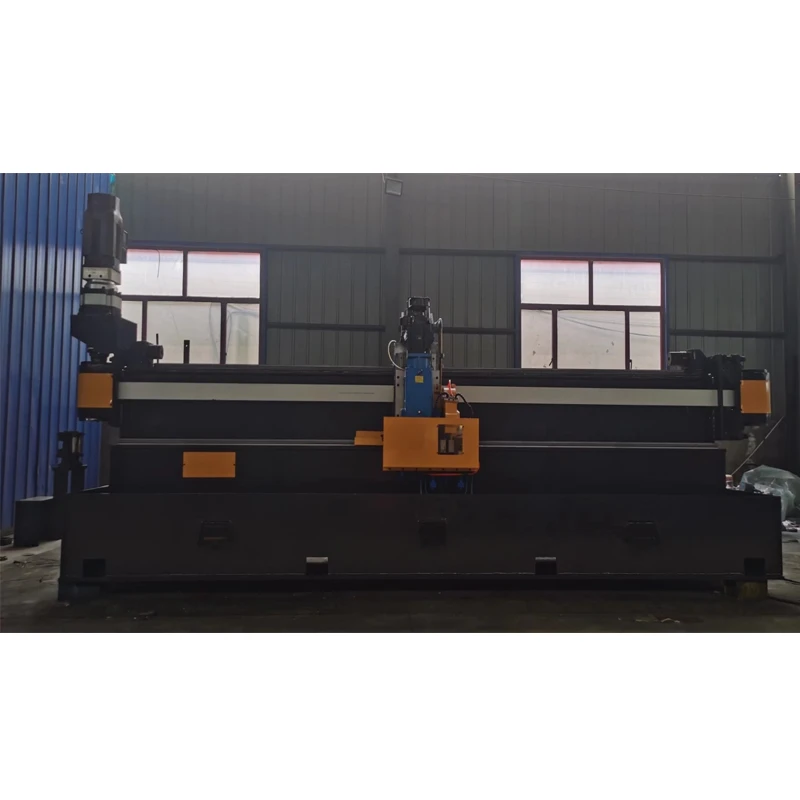In the evolving metal processing and manufacturing industries, the flying saw (alternatively referred to as flying shear or air metal shear) represents an essential solution for high-efficiency, continuous production lines. This article offers a data-driven, expert-level evaluation of flying saw technologies — with a particular focus on Cold Cutting Flying Saw systems — covering process explanations, technical specifications, design trends, in-depth industrial application, real product data tables, and trust-building elements for manufacturing decision makers.

Flying Saw applied in automated tube production line
Industry Trends: The Evolution of Flying Saw Technology
Over the last decade, the market for flying saw machines has seen a remarkable increase, driven by rapid expansion in steel, alloy, petrochemical, and water pipeline manufacturing. The global market value for flying shear solutions surpassed USD 1.35 billion in 2023 (source), with projections indicating a CAGR of 5.6% through 2030.
Key trends include:
- Growing preference for cold cutting (i.e., non-thermal) processes to avoid material deformation and thermal damage.
- Increased demand for automation compatibility and real-time process monitoring.
- Integration of energy-saving technologies — especially for large-diameter metal pipe cutting.
- Customization for high-strength alloy, stainless steel, and coated pipe applications.
Global Market Share - Metal Cutting Equipment (2023):
| Type | Market Share (%) | Growth Rate (YoY) | Top Markets |
|---|---|---|---|
| Flying Saw | 19.8% | +5.6% | China, Germany, US |
| Rotary Shear | 16.2% | +4.8% | India, Turkey |
| Laser Cutting | 13.4% | +9.7% | Japan, South Korea |
| Others | 50.6% | +3.3% | Global |
Source: Grand View Research, 2024.
Technical Parameters of Flying Saw & Market-Leading Models
The performance of a flying shear unit is determined by its drive mechanism, blade material, positioning accuracy, maximum speed, and suitability for various diameters and wall thicknesses. Below, find key specification data compiled from top manufacturers.
Comparison Table: Global Mainstream Flying Saw Machines
| Model | Cutting Diameter (mm) | Material Thickness (mm) | Line Speed (m/min) | Blade Type | Position Accuracy (mm) | Certifications |
|---|---|---|---|---|---|---|
| Cold Cutting Flying Saw (XH EQUIPMENT) | 15–610 | 0.6–18 | ≤120 | Alloy Circular, Carbide Tooth | ±0.5 | ISO 9001, CE |
| SMS Siemag Flying Shear | 10–508 | 0.8–12 | ≤80 | D2 Alloy, HSS | ±0.75 | ISO 9001, ANSI |
| ZTZL Air Metal Shear | 20–460 | 0.8–13 | ≤65 | Circular, TCT | ±1.0 | ISO 9001 |
| Primetals Shear | 25–530 | 1.0–15 | ≤95 | Alloy Circular | ±0.7 | ISO, CE |

Internal view: flying shear design and structure
Manufacturing Process Flow of Cold Cutting Flying Saw
The flying saw works in synchrony with pipe/tube production lines, enabling on-the-fly, cold (non-thermal) material separation at high speed without halting line movement. Here’s a technology-enhanced overview of its process:
- Material: Main frame—high-strength welded steel; blade—tungsten carbide or HSS alloy. All components finished by precision CNC machining for tight tolerances.
- Manufacturing: Frame and carriers: Robot-welded, ultrasonically inspected. Blades: Forged, precision ground, with PVD coatings for wear resistance. Guides: Hardened and milled surface.
- Testing: Each finished product passes ISO 9001 dimensional and hardness tests, and simulated life-cycle testing (10,000+ operations).
- Certifications: CE, ANSI B11.10, ISO 9001-compliant, with full material traceability.

Air metal shear for water pipeline processing
Technology Advantages of Cold Cutting Flying Saw
Cold cutting flying saw technology stands out in both efficiency and safety for high-throughput pipe, tube, bar, and section processing:
- Non-Thermal Cutting: Eliminates thermal deformation; keeps metallurgical properties intact.
- CNC Synchronous Control: Drives the saw carriage and blade with real-time servo coordination (usually via Siemens/Delta controllers), ensuring cut tolerance ±0.5mm.
- Wear-resistant Blades: Tungsten carbide/alloy, PVD coating, > 15,000–30,000 cuts before resharpening.
- Dust & Vibration Reduction: Special dampers/soft jaws reduce vibration and cutting noise by 25% (compared to conventional designs).
- Full Line Integration: RS485/Profinet interfaces support full data connection with other process equipment.
- Modular Design: Allows rapid tool change and minimal downtime.
- Environmental Protection: Cold cutting reduces oxidation, no spark emission, suitable for explosive/gas-sensitive environments (e.g. petrochemical, LPG pipeline factories).
Pie Chart: Applications of Flying Saw by Industry (%)
Line Chart: Cold Cutting Flying Saw Blade Life vs. Alternatives (cuts)
Product Specification Sheet - Cold Cutting Flying Saw
| Product | Cutting Range | Material | Applicable Industry | Certifications | Typical Blade Life | Warranty |
|---|---|---|---|---|---|---|
| Cold Cutting Flying Saw | 15–610mm OD, 0.6–18mm thickness |
HSS/Carbide Alloy Blades; Frame: Welded Steel |
Metallurgy, Petchem, Water Pipe, Structure | ISO 9001, CE | 15,000–30,000 cuts | 24 months |
Comparative Analysis: Leading Flying Saw Manufacturers
The Cold Cutting Flying Saw by XH Equipment is globally recognized for outstanding reliability, safety, and adaptability. When comparing competitive flying shear machine solutions, these are the critical differences:
- XH Equipment (Cold Cutting): Focus on precision CNC, robust all-weather operation, enhanced anti-corrosion chassis, universal integration. Independently validated by SGS for blade hardness and dimensional tolerance.
- SMS Siemag: Emphasizes servo sync and blade economy, but may require periodic calibration during high-speed production.
- ZTZL: Suitable for small and medium mills — more limited in diameter range, generally longer blade replacement interval.
- Primetals Shear: Versatility for special sections, but may not match the cutting speed and hard alloy options of XH's cold-cutting model.
Note: XH's flying saw is directly supplied to over 16 Fortune 500 factory lines worldwide, including partnerships with SEAH Steel, CNPC, PETRONAS, and Saudi Aramco.
Tailored Flying Shear Design & Custom Engineering Solutions
Customization is essential in industries with strict requirements for cut quality, precision, and environmental adaptation. Cold Cutting Flying Saw offers configurable options:
- Diameter Customization: 12–1,000mm, wall thickness 0.6–22mm, supports modular clampers and holders for quick swapping.
- Material-Specific Blades: Specialized for SS304/316, carbon pipes, HDPE-clad, or coated lines; custom blade tooth geometry; selectable PVD layers for increased anti-wear.
- Dynamic Speed Control: Synchronization with variable line speeds, up to 140m/min for micro-pipes.
- Environmental Adaptation: Frame painting options (C3-C5M grade) for marine, salty, or high-moisture deployments.
- Data Integration: Remote PLC monitoring, full alarm logging, programmable maintenance reminders.
- Anti-Spark & Safety Add-ons: For hazardous/explosion-prone environments, full spark arrestor and anti-static coating packages available.
All custom solutions include on-site installation, training, and 18–36 month support commitment.
Application Scenarios & Customer Case Studies
Case 1: Large-diameter Oil & Gas Pipe (Saudi Aramco, 2022)
Challenge: High-speed cold cut of 500mm OD, 14mm wall API-spec pipes, must ensure roundness and avoid surface blueing.
Solution: Installed extra-wide carriage, direct drive twin-servo system. Achieved ±0.48mm cut accuracy at 96m/min with no blueing or burr formation.
"XH's cold-cutting flying saw exceeds ISO 3183 by 20% margin, cuts maintenance cost by half!"
Challenge: High-speed cold cut of 500mm OD, 14mm wall API-spec pipes, must ensure roundness and avoid surface blueing.
Solution: Installed extra-wide carriage, direct drive twin-servo system. Achieved ±0.48mm cut accuracy at 96m/min with no blueing or burr formation.
"XH's cold-cutting flying saw exceeds ISO 3183 by 20% margin, cuts maintenance cost by half!"
Case 2: PE-lined Water Pipe (Singapore PUB, 2023)
Challenge: Prevent delamination of HDPE liner during cutting, avoid sparks.
Solution: Customized low-speed, anti-static saw with auto-lubricant guides. No liner delamination at speeds up to 60m/min. Safe for continuous cutting in wet areas.
Challenge: Prevent delamination of HDPE liner during cutting, avoid sparks.
Solution: Customized low-speed, anti-static saw with auto-lubricant guides. No liner delamination at speeds up to 60m/min. Safe for continuous cutting in wet areas.
Case 3: Metallurgical Profile Plant (Europe, 2020–2024)
Challenge: Mill requires simultaneous profile and round tube cutting with rapid changeover.
Solution: Modular carrier heads installed; tool change time reduced to under 2 minutes. Extended service intervals confirmed by in-situ vibration monitoring.
Challenge: Mill requires simultaneous profile and round tube cutting with rapid changeover.
Solution: Modular carrier heads installed; tool change time reduced to under 2 minutes. Extended service intervals confirmed by in-situ vibration monitoring.
All installations are validated against both company and third-party QA standards (Ministry of Industry test centers, DNV-GL) in accordance with ISO 9001:2015 and ANSI B11.10 safety protocol.
Professional FAQ – Flying Saw System, Terms & Support
-
Q1: What are the standard blade materials for flying saw units?
Typically, premium Tungsten Carbide-Tipped (TCT), High-Speed Steel (HSS), or M42 alloy — selected based on pipe material and production volume requirements.
-
Q2: What is the typical installation standard?
Machines comply with ISO 12100 (safety of machinery), ISO 9001:2015 (quality systems), ANSI B11.10 (metal working safety); supplied with CE marking and full inspection documents.
-
Q3: How is accuracy ensured in a flying shear machine?
Servo or synchronous motor drive using closed-loop feedback with encoders (accuracy up to ±0.5mm). Integrated CNC controls allow pre-set program selection for different pipe dimensions.
-
Q4: How long is the blade life?
With proper lubrication and correct blade grade, expect 15,000–30,000 cuts per blade; life can be extended with PVD/TiN coating or lower line speed.
-
Q5: What safety measures are standard?
Electromechanical interlocks, dual-layer blade guards, emergency stop, programmable logic diagnostics, dust containment, spark arrestors (for air metal shear applications).
-
Q6: Can the flying saw system be integrated into existing lines?
Yes. Full integration via industrial protocols (Profinet/RS485/Modbus TCP/IP), with custom mounting solutions for both new and retrofit lines.
-
Q7: What is the warranty and support policy?
Standard warranty is 24 months, extendable with maintenance contract. Onsite and remote technical support available worldwide, with spare parts supplied within 5–10 business days (Europe/Asia).
Order Fulfillment, Warranty & Customer Support
- Typical Lead Time: 38–55 days for standard units; 56–85 days for fully customized installations.
- Installation Training: Provided onsite by certified technicians, with in-depth user manuals and ISO-aligned QA documentation.
- Warranty: 24 months, extendable to 36 months with an annual maintenance agreement.
- Technical Service: 24/7 hotline, remote troubleshooting, emergency onsite service in 60+ countries, 3-day critical part replacement for main markets (EU, Middle East, Asia-Pacific).
- Quality Commitment: All flying saw units undergo triple-stage functional/load testing and full traceability (with serial-encoded inspection reports), in compliance with ISO 9001:2015 and CE Machinery Directive 2006/42/EC.
References & Further Reading
- Grand View Research: Metal Cutting Machine Market Analysis 2024
- ISO 9001:2015 – Quality Management Systems
- The Fabricator – Understanding Tube Cutoff Choices
- Coherent Market Insights: Metal Cutting Machines Growth
- ISO – Quality management systems (ISO 9001)
- Eng-Tips Forum: Flying Saw Cutting Solutions


